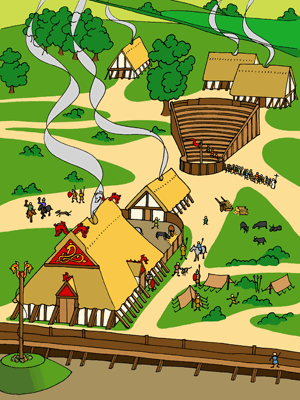|

|
|

of the Rich &
Famous
 Saxon
kings, thanes (lords) and bishops were very rich and powerful in the Dark
Ages. They often lived in big
wooden buildings known as 'Great Halls'. Saxon
kings, thanes (lords) and bishops were very rich and powerful in the Dark
Ages. They often lived in big
wooden buildings known as 'Great Halls'.- These were the equivalent of
mansions or palaces today. They looked a bit like huge barns.
- A great
hall is described in the 'Beowulf'
poem.
- They were built of big wooden
beams. The walls were filled in with either wattle & daub
(wickerwork covered in mud and animal poo!) or wooden planks or
'staves'.
- Some halls may have had an
upstairs (as shown on the Bayeux Tapestry). In late Saxon times, extremely rich
kings built them of stone.
- The roofs were thatched with
reeds or straw; or covered in wooden shingles.
- Lords had smaller great halls to
kings. A king might have two great
halls, one next to the other. Nearby were smaller buildings used for lots of different purposes. There would be a big wooden wall around
the lot, called a 'palisade'. Everything together made up an estate or
a
palace.
- Archaeologists have dug up great
halls in palaces at Cheddar (in Somerset) and Yeavering (in Northumberland).
- King Alfred of Wessex's palace
at Cheddar had one great hall. There were lots
of smaller buildings too. People lived there throughout the 9th and
10th centuries.
- King Edwin of
Northumbria's
palace at Yeavering had two great halls (see picture). Amongst other buildings,
there was also a 'corral' for keeping cattle in and a grandstand in
which to hold meetings. People lived there throughout the 7th century.
- Activity
Sheet available.
But what
was it like inside a Great Hall?
|

